Challenges and Success Factors of ERP Systems in Startup IT Orgs
VerifiedAdded on 2020/04/15
|11
|2305
|40
Report
AI Summary
This expression of interest report explores the challenges and success factors of implementing ERP systems in startup IT organizations, particularly within the Australian context. The report highlights the potential of cloud-based ERP solutions for startups, offering cost-effective alternatives to traditional systems. Key challenges identified include managing costs, aligning software with business processes, and customizing training and governance. These challenges are then framed as critical success factors for ERP adoption. The report reviews existing literature, identifies research problems, and emphasizes the importance of factors like resource allocation and management commitment. The project's rationale is to study the risks and benefits of ERP implementation, focusing on the benefits for stakeholders through improved resource management and system usage. The report aims to provide guidelines for Australian startup IT organizations to navigate the complexities of ERP implementation, ensuring scalability, flexibility, and overall system benefits.

Running head: EXPRESSION OF INTEREST
Challenges and Success factors of ERP system in startup IT organizations: Expression of Interest
Name of the Student
Name of the University
Author’s Note
Challenges and Success factors of ERP system in startup IT organizations: Expression of Interest
Name of the Student
Name of the University
Author’s Note
Paraphrase This Document
Need a fresh take? Get an instant paraphrase of this document with our AI Paraphraser
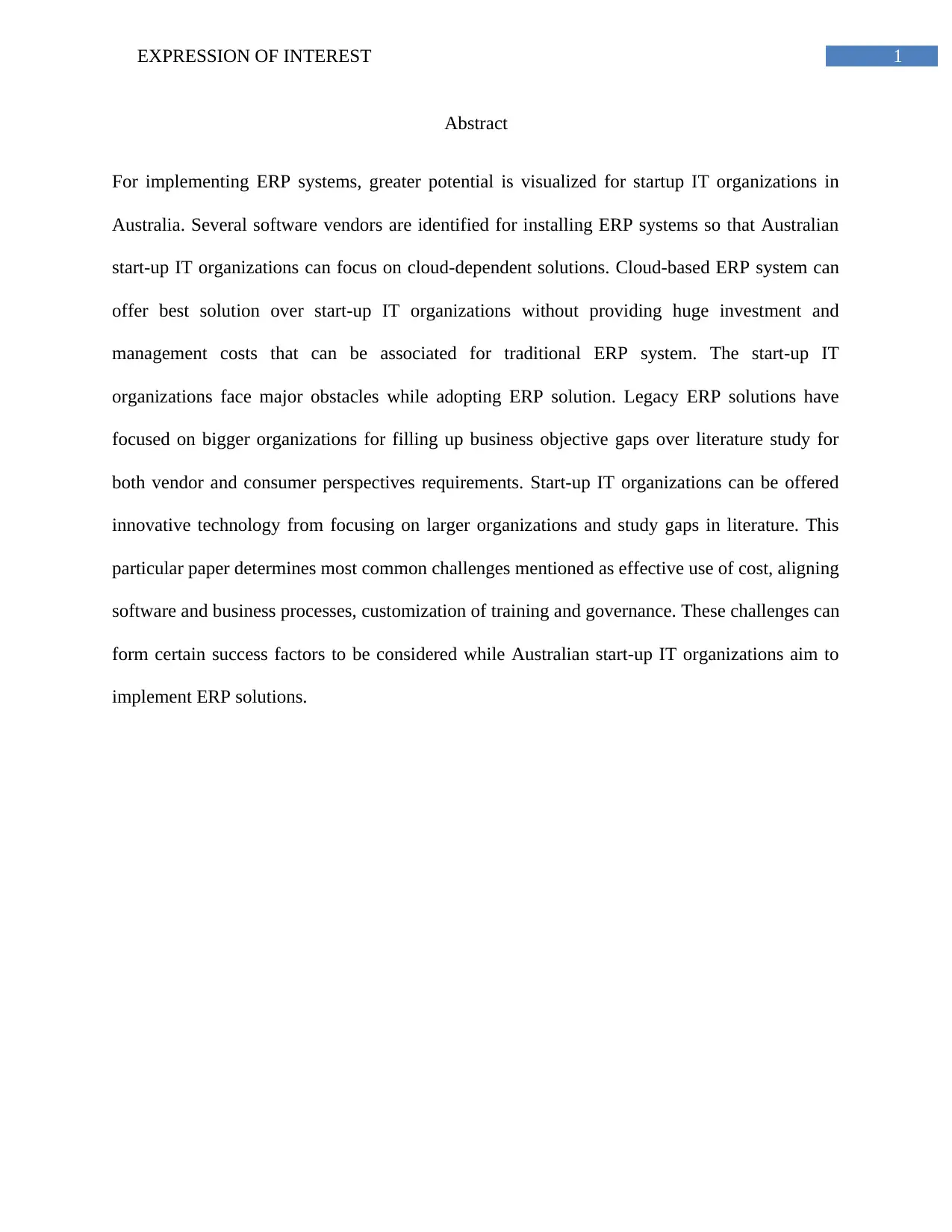
1EXPRESSION OF INTEREST
Abstract
For implementing ERP systems, greater potential is visualized for startup IT organizations in
Australia. Several software vendors are identified for installing ERP systems so that Australian
start-up IT organizations can focus on cloud-dependent solutions. Cloud-based ERP system can
offer best solution over start-up IT organizations without providing huge investment and
management costs that can be associated for traditional ERP system. The start-up IT
organizations face major obstacles while adopting ERP solution. Legacy ERP solutions have
focused on bigger organizations for filling up business objective gaps over literature study for
both vendor and consumer perspectives requirements. Start-up IT organizations can be offered
innovative technology from focusing on larger organizations and study gaps in literature. This
particular paper determines most common challenges mentioned as effective use of cost, aligning
software and business processes, customization of training and governance. These challenges can
form certain success factors to be considered while Australian start-up IT organizations aim to
implement ERP solutions.
Abstract
For implementing ERP systems, greater potential is visualized for startup IT organizations in
Australia. Several software vendors are identified for installing ERP systems so that Australian
start-up IT organizations can focus on cloud-dependent solutions. Cloud-based ERP system can
offer best solution over start-up IT organizations without providing huge investment and
management costs that can be associated for traditional ERP system. The start-up IT
organizations face major obstacles while adopting ERP solution. Legacy ERP solutions have
focused on bigger organizations for filling up business objective gaps over literature study for
both vendor and consumer perspectives requirements. Start-up IT organizations can be offered
innovative technology from focusing on larger organizations and study gaps in literature. This
particular paper determines most common challenges mentioned as effective use of cost, aligning
software and business processes, customization of training and governance. These challenges can
form certain success factors to be considered while Australian start-up IT organizations aim to
implement ERP solutions.
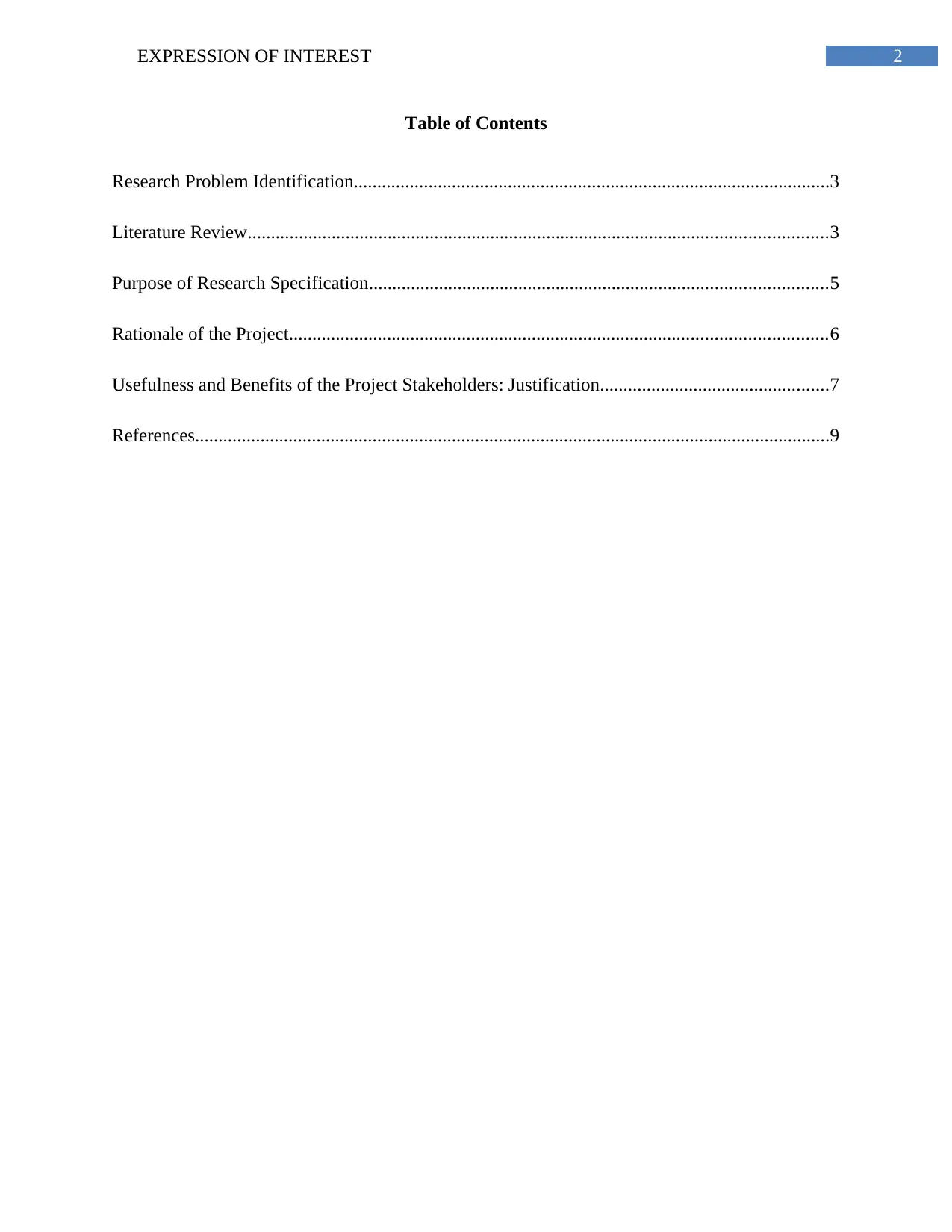
2EXPRESSION OF INTEREST
Table of Contents
Research Problem Identification......................................................................................................3
Literature Review............................................................................................................................3
Purpose of Research Specification..................................................................................................5
Rationale of the Project...................................................................................................................6
Usefulness and Benefits of the Project Stakeholders: Justification.................................................7
References........................................................................................................................................9
Table of Contents
Research Problem Identification......................................................................................................3
Literature Review............................................................................................................................3
Purpose of Research Specification..................................................................................................5
Rationale of the Project...................................................................................................................6
Usefulness and Benefits of the Project Stakeholders: Justification.................................................7
References........................................................................................................................................9
⊘ This is a preview!⊘
Do you want full access?
Subscribe today to unlock all pages.

Trusted by 1+ million students worldwide
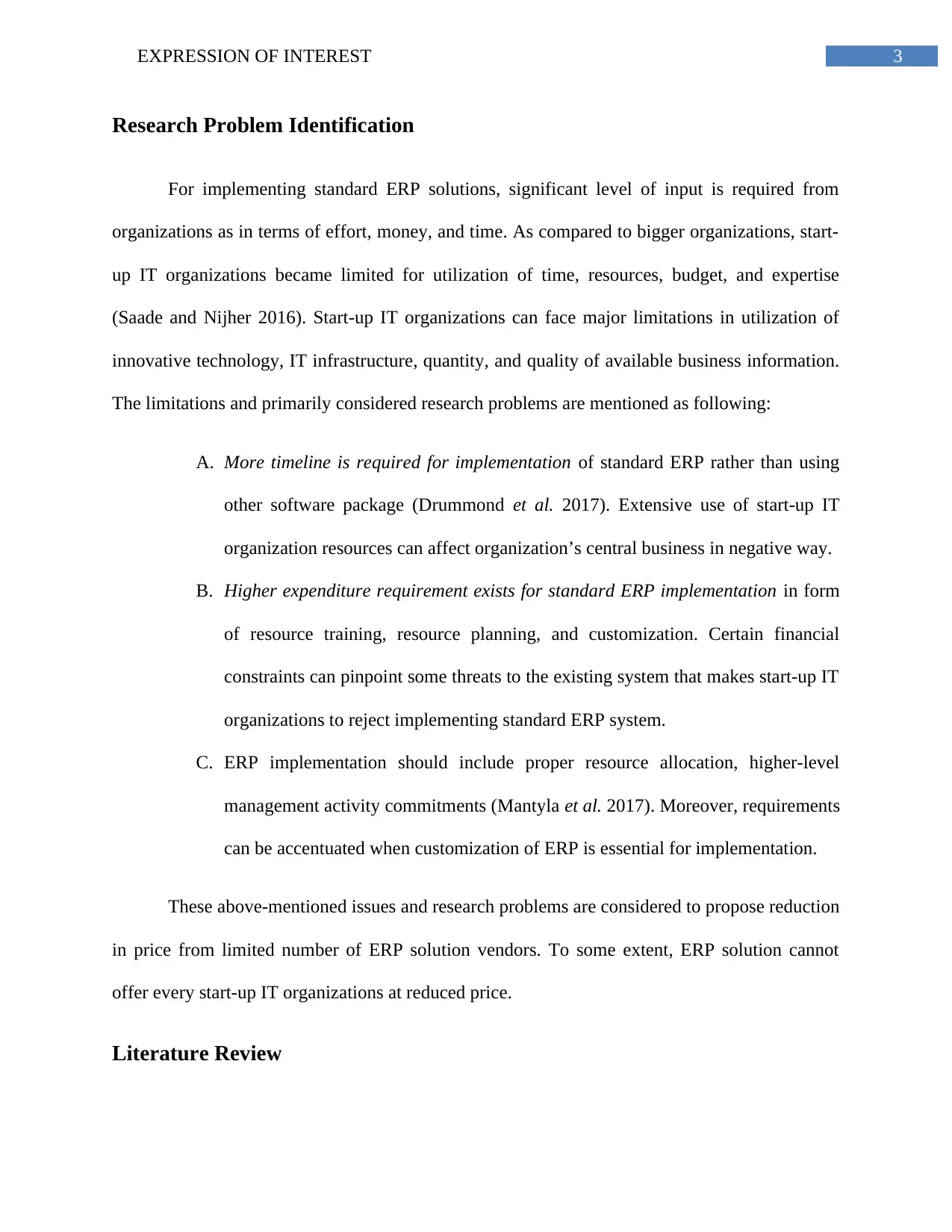
3EXPRESSION OF INTEREST
Research Problem Identification
For implementing standard ERP solutions, significant level of input is required from
organizations as in terms of effort, money, and time. As compared to bigger organizations, start-
up IT organizations became limited for utilization of time, resources, budget, and expertise
(Saade and Nijher 2016). Start-up IT organizations can face major limitations in utilization of
innovative technology, IT infrastructure, quantity, and quality of available business information.
The limitations and primarily considered research problems are mentioned as following:
A. More timeline is required for implementation of standard ERP rather than using
other software package (Drummond et al. 2017). Extensive use of start-up IT
organization resources can affect organization’s central business in negative way.
B. Higher expenditure requirement exists for standard ERP implementation in form
of resource training, resource planning, and customization. Certain financial
constraints can pinpoint some threats to the existing system that makes start-up IT
organizations to reject implementing standard ERP system.
C. ERP implementation should include proper resource allocation, higher-level
management activity commitments (Mantyla et al. 2017). Moreover, requirements
can be accentuated when customization of ERP is essential for implementation.
These above-mentioned issues and research problems are considered to propose reduction
in price from limited number of ERP solution vendors. To some extent, ERP solution cannot
offer every start-up IT organizations at reduced price.
Literature Review
Research Problem Identification
For implementing standard ERP solutions, significant level of input is required from
organizations as in terms of effort, money, and time. As compared to bigger organizations, start-
up IT organizations became limited for utilization of time, resources, budget, and expertise
(Saade and Nijher 2016). Start-up IT organizations can face major limitations in utilization of
innovative technology, IT infrastructure, quantity, and quality of available business information.
The limitations and primarily considered research problems are mentioned as following:
A. More timeline is required for implementation of standard ERP rather than using
other software package (Drummond et al. 2017). Extensive use of start-up IT
organization resources can affect organization’s central business in negative way.
B. Higher expenditure requirement exists for standard ERP implementation in form
of resource training, resource planning, and customization. Certain financial
constraints can pinpoint some threats to the existing system that makes start-up IT
organizations to reject implementing standard ERP system.
C. ERP implementation should include proper resource allocation, higher-level
management activity commitments (Mantyla et al. 2017). Moreover, requirements
can be accentuated when customization of ERP is essential for implementation.
These above-mentioned issues and research problems are considered to propose reduction
in price from limited number of ERP solution vendors. To some extent, ERP solution cannot
offer every start-up IT organizations at reduced price.
Literature Review
Paraphrase This Document
Need a fresh take? Get an instant paraphrase of this document with our AI Paraphraser
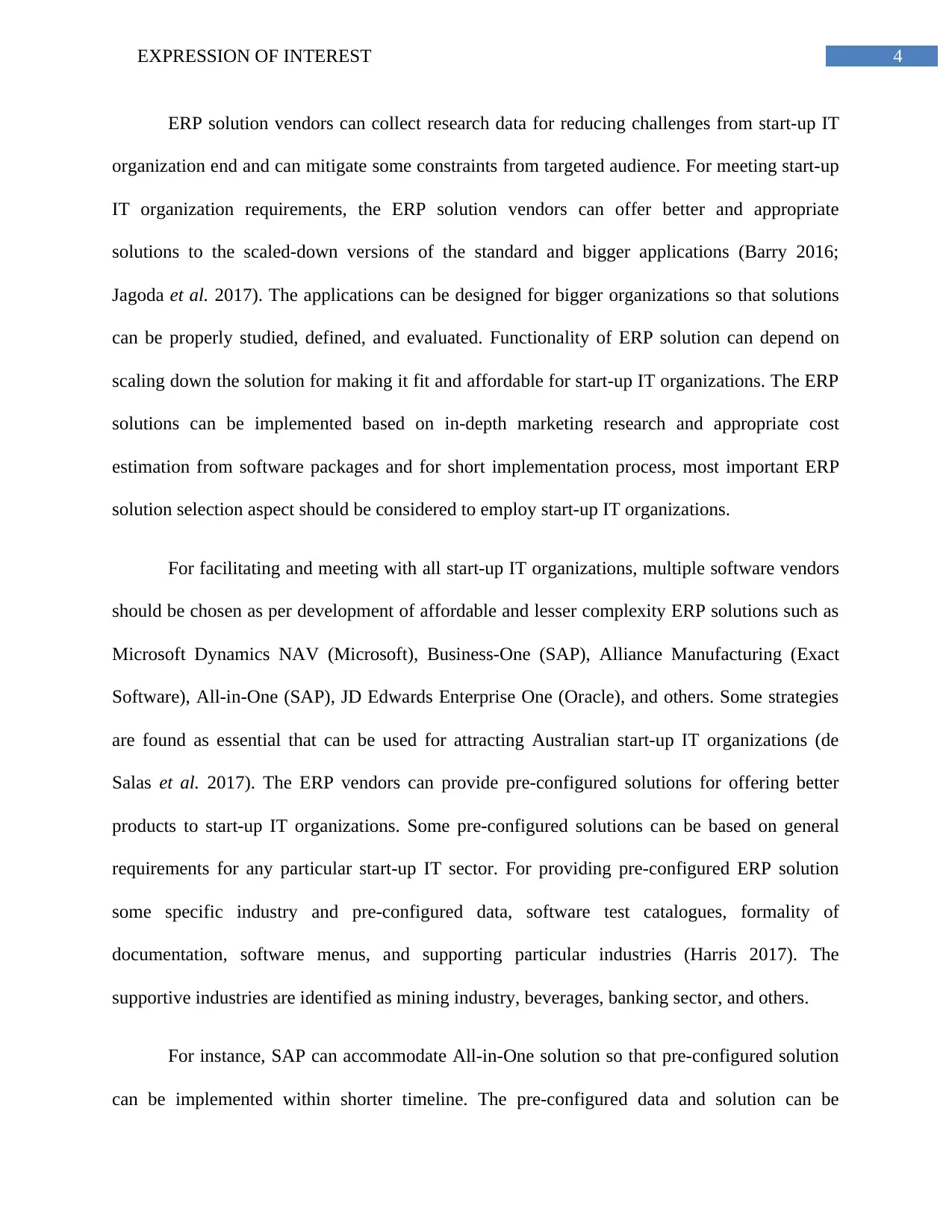
4EXPRESSION OF INTEREST
ERP solution vendors can collect research data for reducing challenges from start-up IT
organization end and can mitigate some constraints from targeted audience. For meeting start-up
IT organization requirements, the ERP solution vendors can offer better and appropriate
solutions to the scaled-down versions of the standard and bigger applications (Barry 2016;
Jagoda et al. 2017). The applications can be designed for bigger organizations so that solutions
can be properly studied, defined, and evaluated. Functionality of ERP solution can depend on
scaling down the solution for making it fit and affordable for start-up IT organizations. The ERP
solutions can be implemented based on in-depth marketing research and appropriate cost
estimation from software packages and for short implementation process, most important ERP
solution selection aspect should be considered to employ start-up IT organizations.
For facilitating and meeting with all start-up IT organizations, multiple software vendors
should be chosen as per development of affordable and lesser complexity ERP solutions such as
Microsoft Dynamics NAV (Microsoft), Business-One (SAP), Alliance Manufacturing (Exact
Software), All-in-One (SAP), JD Edwards Enterprise One (Oracle), and others. Some strategies
are found as essential that can be used for attracting Australian start-up IT organizations (de
Salas et al. 2017). The ERP vendors can provide pre-configured solutions for offering better
products to start-up IT organizations. Some pre-configured solutions can be based on general
requirements for any particular start-up IT sector. For providing pre-configured ERP solution
some specific industry and pre-configured data, software test catalogues, formality of
documentation, software menus, and supporting particular industries (Harris 2017). The
supportive industries are identified as mining industry, beverages, banking sector, and others.
For instance, SAP can accommodate All-in-One solution so that pre-configured solution
can be implemented within shorter timeline. The pre-configured data and solution can be
ERP solution vendors can collect research data for reducing challenges from start-up IT
organization end and can mitigate some constraints from targeted audience. For meeting start-up
IT organization requirements, the ERP solution vendors can offer better and appropriate
solutions to the scaled-down versions of the standard and bigger applications (Barry 2016;
Jagoda et al. 2017). The applications can be designed for bigger organizations so that solutions
can be properly studied, defined, and evaluated. Functionality of ERP solution can depend on
scaling down the solution for making it fit and affordable for start-up IT organizations. The ERP
solutions can be implemented based on in-depth marketing research and appropriate cost
estimation from software packages and for short implementation process, most important ERP
solution selection aspect should be considered to employ start-up IT organizations.
For facilitating and meeting with all start-up IT organizations, multiple software vendors
should be chosen as per development of affordable and lesser complexity ERP solutions such as
Microsoft Dynamics NAV (Microsoft), Business-One (SAP), Alliance Manufacturing (Exact
Software), All-in-One (SAP), JD Edwards Enterprise One (Oracle), and others. Some strategies
are found as essential that can be used for attracting Australian start-up IT organizations (de
Salas et al. 2017). The ERP vendors can provide pre-configured solutions for offering better
products to start-up IT organizations. Some pre-configured solutions can be based on general
requirements for any particular start-up IT sector. For providing pre-configured ERP solution
some specific industry and pre-configured data, software test catalogues, formality of
documentation, software menus, and supporting particular industries (Harris 2017). The
supportive industries are identified as mining industry, beverages, banking sector, and others.
For instance, SAP can accommodate All-in-One solution so that pre-configured solution
can be implemented within shorter timeline. The pre-configured data and solution can be

5EXPRESSION OF INTEREST
developed based on Australian start-up IT organizations so that best practice for project
management methodology can be followed. In Australia, some start-up companies have utilized
pre-configured ERP system implementation (Ge, Liu and Ma 2018). ERP solution vendors can
follow proper flexibility over pricing among ERP products for targeting to Australian start-up
organizations. The Australian start-up IT organizations can meet immediate requirements and
buying add-on software components for deployment. Moreover, the ERP pricing strategies can
be considered as attractive part where cloud-hosted application can be used (Al-Isma’ili et al.
2016). Flexibility in business decisions can allow the ERP pricing solutions for investing in ERP
as per budget with buying minimum licenses that are needed.
New pricing strategy can be used for multiple software vendors in financing of ERP
solution for start-up IT organizations. The financing services for ERP can provide reasonable
solution based on pricing and cost expenses. However, to some extent, it is possible that start-up
IT organizations can purchase ERP solution based financing schemes used for covering certain
costs over well-defined payments made in monthly basis (Thompson 2017). For instance, SAP
can offer start-up IT businesses with potential way of cost scheme that is related with SAP
implementation process for next seven years. the payments can be made with including SAP
software cost, third-party software cost, installation, customization, and training cost. In an
overall, ERP software vendors can offer separate and different types of pricing planning so that
ERP planning activity can attract start-up IT organizations (Siddique and Hussein 2016). Pricing
of implementation can be based on certain module specifications, subscriptions, annual upgrade,
support system, and number of licenses.
Purpose of Research Specification
developed based on Australian start-up IT organizations so that best practice for project
management methodology can be followed. In Australia, some start-up companies have utilized
pre-configured ERP system implementation (Ge, Liu and Ma 2018). ERP solution vendors can
follow proper flexibility over pricing among ERP products for targeting to Australian start-up
organizations. The Australian start-up IT organizations can meet immediate requirements and
buying add-on software components for deployment. Moreover, the ERP pricing strategies can
be considered as attractive part where cloud-hosted application can be used (Al-Isma’ili et al.
2016). Flexibility in business decisions can allow the ERP pricing solutions for investing in ERP
as per budget with buying minimum licenses that are needed.
New pricing strategy can be used for multiple software vendors in financing of ERP
solution for start-up IT organizations. The financing services for ERP can provide reasonable
solution based on pricing and cost expenses. However, to some extent, it is possible that start-up
IT organizations can purchase ERP solution based financing schemes used for covering certain
costs over well-defined payments made in monthly basis (Thompson 2017). For instance, SAP
can offer start-up IT businesses with potential way of cost scheme that is related with SAP
implementation process for next seven years. the payments can be made with including SAP
software cost, third-party software cost, installation, customization, and training cost. In an
overall, ERP software vendors can offer separate and different types of pricing planning so that
ERP planning activity can attract start-up IT organizations (Siddique and Hussein 2016). Pricing
of implementation can be based on certain module specifications, subscriptions, annual upgrade,
support system, and number of licenses.
Purpose of Research Specification
⊘ This is a preview!⊘
Do you want full access?
Subscribe today to unlock all pages.

Trusted by 1+ million students worldwide
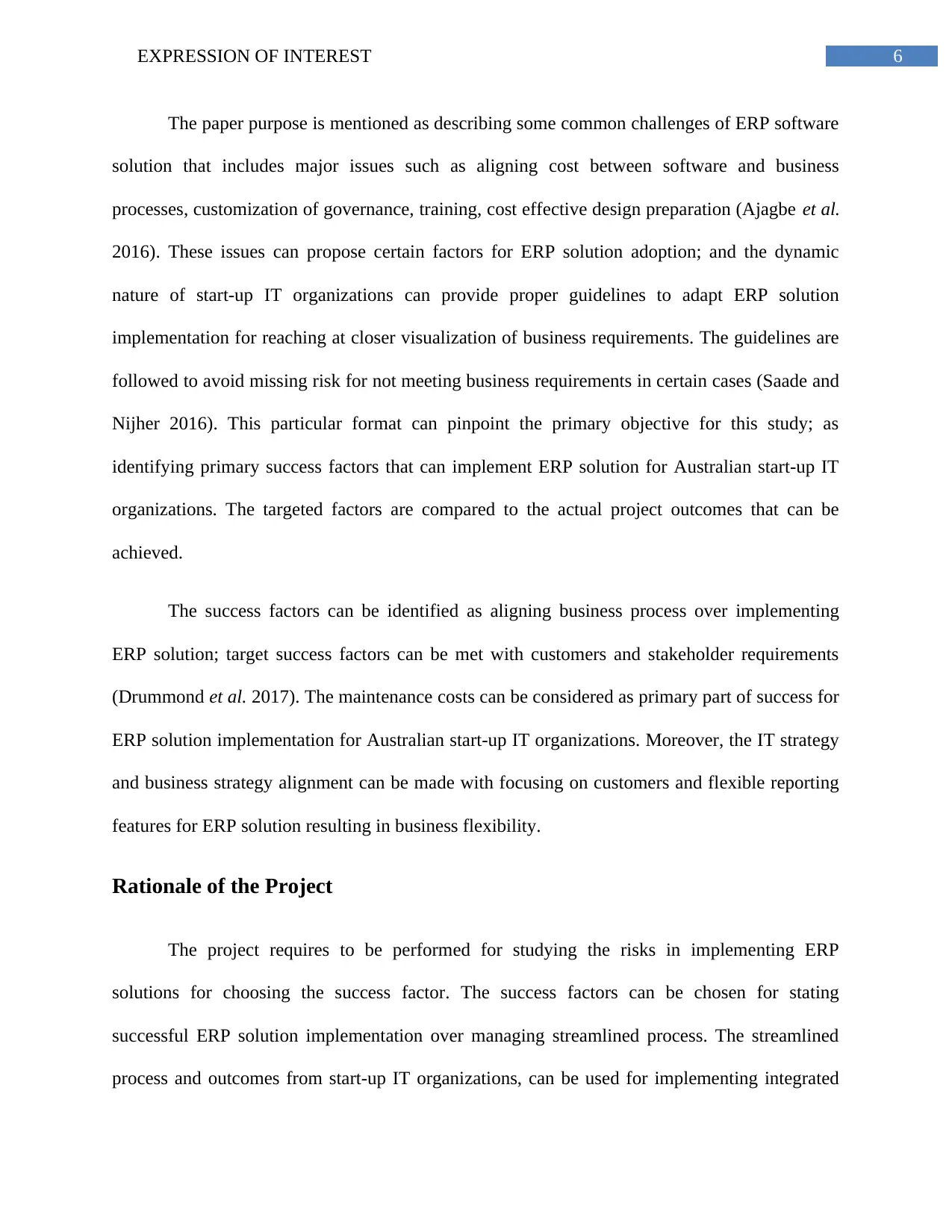
6EXPRESSION OF INTEREST
The paper purpose is mentioned as describing some common challenges of ERP software
solution that includes major issues such as aligning cost between software and business
processes, customization of governance, training, cost effective design preparation (Ajagbe et al.
2016). These issues can propose certain factors for ERP solution adoption; and the dynamic
nature of start-up IT organizations can provide proper guidelines to adapt ERP solution
implementation for reaching at closer visualization of business requirements. The guidelines are
followed to avoid missing risk for not meeting business requirements in certain cases (Saade and
Nijher 2016). This particular format can pinpoint the primary objective for this study; as
identifying primary success factors that can implement ERP solution for Australian start-up IT
organizations. The targeted factors are compared to the actual project outcomes that can be
achieved.
The success factors can be identified as aligning business process over implementing
ERP solution; target success factors can be met with customers and stakeholder requirements
(Drummond et al. 2017). The maintenance costs can be considered as primary part of success for
ERP solution implementation for Australian start-up IT organizations. Moreover, the IT strategy
and business strategy alignment can be made with focusing on customers and flexible reporting
features for ERP solution resulting in business flexibility.
Rationale of the Project
The project requires to be performed for studying the risks in implementing ERP
solutions for choosing the success factor. The success factors can be chosen for stating
successful ERP solution implementation over managing streamlined process. The streamlined
process and outcomes from start-up IT organizations, can be used for implementing integrated
The paper purpose is mentioned as describing some common challenges of ERP software
solution that includes major issues such as aligning cost between software and business
processes, customization of governance, training, cost effective design preparation (Ajagbe et al.
2016). These issues can propose certain factors for ERP solution adoption; and the dynamic
nature of start-up IT organizations can provide proper guidelines to adapt ERP solution
implementation for reaching at closer visualization of business requirements. The guidelines are
followed to avoid missing risk for not meeting business requirements in certain cases (Saade and
Nijher 2016). This particular format can pinpoint the primary objective for this study; as
identifying primary success factors that can implement ERP solution for Australian start-up IT
organizations. The targeted factors are compared to the actual project outcomes that can be
achieved.
The success factors can be identified as aligning business process over implementing
ERP solution; target success factors can be met with customers and stakeholder requirements
(Drummond et al. 2017). The maintenance costs can be considered as primary part of success for
ERP solution implementation for Australian start-up IT organizations. Moreover, the IT strategy
and business strategy alignment can be made with focusing on customers and flexible reporting
features for ERP solution resulting in business flexibility.
Rationale of the Project
The project requires to be performed for studying the risks in implementing ERP
solutions for choosing the success factor. The success factors can be chosen for stating
successful ERP solution implementation over managing streamlined process. The streamlined
process and outcomes from start-up IT organizations, can be used for implementing integrated
Paraphrase This Document
Need a fresh take? Get an instant paraphrase of this document with our AI Paraphraser
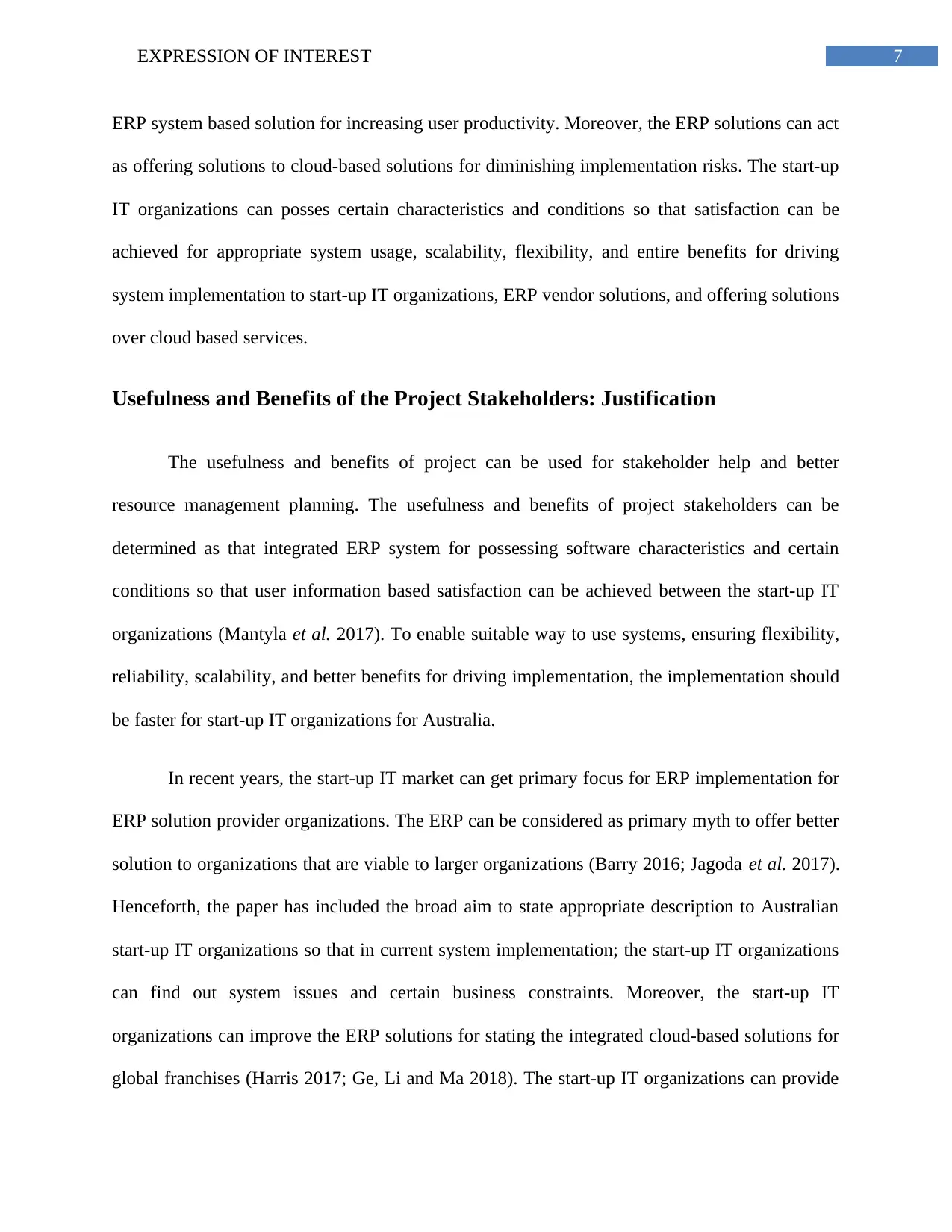
7EXPRESSION OF INTEREST
ERP system based solution for increasing user productivity. Moreover, the ERP solutions can act
as offering solutions to cloud-based solutions for diminishing implementation risks. The start-up
IT organizations can posses certain characteristics and conditions so that satisfaction can be
achieved for appropriate system usage, scalability, flexibility, and entire benefits for driving
system implementation to start-up IT organizations, ERP vendor solutions, and offering solutions
over cloud based services.
Usefulness and Benefits of the Project Stakeholders: Justification
The usefulness and benefits of project can be used for stakeholder help and better
resource management planning. The usefulness and benefits of project stakeholders can be
determined as that integrated ERP system for possessing software characteristics and certain
conditions so that user information based satisfaction can be achieved between the start-up IT
organizations (Mantyla et al. 2017). To enable suitable way to use systems, ensuring flexibility,
reliability, scalability, and better benefits for driving implementation, the implementation should
be faster for start-up IT organizations for Australia.
In recent years, the start-up IT market can get primary focus for ERP implementation for
ERP solution provider organizations. The ERP can be considered as primary myth to offer better
solution to organizations that are viable to larger organizations (Barry 2016; Jagoda et al. 2017).
Henceforth, the paper has included the broad aim to state appropriate description to Australian
start-up IT organizations so that in current system implementation; the start-up IT organizations
can find out system issues and certain business constraints. Moreover, the start-up IT
organizations can improve the ERP solutions for stating the integrated cloud-based solutions for
global franchises (Harris 2017; Ge, Li and Ma 2018). The start-up IT organizations can provide
ERP system based solution for increasing user productivity. Moreover, the ERP solutions can act
as offering solutions to cloud-based solutions for diminishing implementation risks. The start-up
IT organizations can posses certain characteristics and conditions so that satisfaction can be
achieved for appropriate system usage, scalability, flexibility, and entire benefits for driving
system implementation to start-up IT organizations, ERP vendor solutions, and offering solutions
over cloud based services.
Usefulness and Benefits of the Project Stakeholders: Justification
The usefulness and benefits of project can be used for stakeholder help and better
resource management planning. The usefulness and benefits of project stakeholders can be
determined as that integrated ERP system for possessing software characteristics and certain
conditions so that user information based satisfaction can be achieved between the start-up IT
organizations (Mantyla et al. 2017). To enable suitable way to use systems, ensuring flexibility,
reliability, scalability, and better benefits for driving implementation, the implementation should
be faster for start-up IT organizations for Australia.
In recent years, the start-up IT market can get primary focus for ERP implementation for
ERP solution provider organizations. The ERP can be considered as primary myth to offer better
solution to organizations that are viable to larger organizations (Barry 2016; Jagoda et al. 2017).
Henceforth, the paper has included the broad aim to state appropriate description to Australian
start-up IT organizations so that in current system implementation; the start-up IT organizations
can find out system issues and certain business constraints. Moreover, the start-up IT
organizations can improve the ERP solutions for stating the integrated cloud-based solutions for
global franchises (Harris 2017; Ge, Li and Ma 2018). The start-up IT organizations can provide
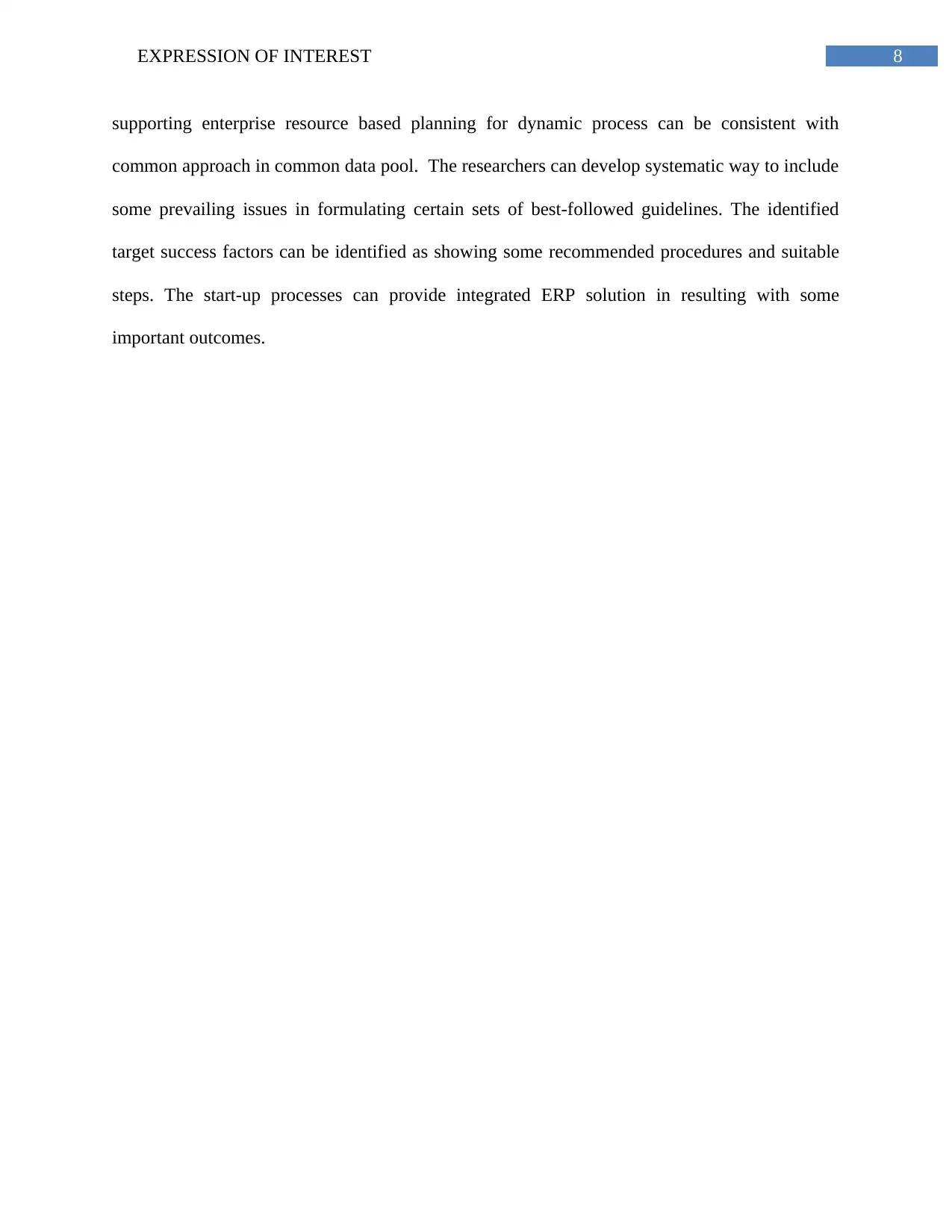
8EXPRESSION OF INTEREST
supporting enterprise resource based planning for dynamic process can be consistent with
common approach in common data pool. The researchers can develop systematic way to include
some prevailing issues in formulating certain sets of best-followed guidelines. The identified
target success factors can be identified as showing some recommended procedures and suitable
steps. The start-up processes can provide integrated ERP solution in resulting with some
important outcomes.
supporting enterprise resource based planning for dynamic process can be consistent with
common approach in common data pool. The researchers can develop systematic way to include
some prevailing issues in formulating certain sets of best-followed guidelines. The identified
target success factors can be identified as showing some recommended procedures and suitable
steps. The start-up processes can provide integrated ERP solution in resulting with some
important outcomes.
⊘ This is a preview!⊘
Do you want full access?
Subscribe today to unlock all pages.

Trusted by 1+ million students worldwide

9EXPRESSION OF INTEREST
References
Ajagbe, M.A., Bih, J., Olujobi, J.O. and Udo, E.E.U., 2016. Which Precedes the other?
Organizational Strategy or Organizational Structure. Which Precedes the other? Organizational
Strategy or Organizational Structure, 2(6), pp.50-66.
Al-Isma’ili, S., Li, M., Shen, J. and He, Q., 2016. Clearing the ‘Cloud’Hanging Over the
Adoption of Cloud Computing in Australian SMEs. Clearing, 12, pp.11-2016.
Barry, S., 2016. Critical factors for successful electronic health record (EHR)
implementation (Doctoral dissertation, Massachusetts Institute of Technology).
de Salas, K., de Salas, K., Lewis, I.J., Lewis, I.J., Huxley, C. and Huxley, C., 2017. Using the
critical process targeting method to improve SMEs’ process understanding: A tale of two
Australian case studies. Business Process Management Journal, 23(2), pp.425-447.
Drummond, P., Drummond, P., Araujo, F., Araujo, F., Borges, R. and Borges, R., 2017. Meeting
halfway: Assessing the differences between the perceptions of ERP implementers and end-
users. Business Process Management Journal, 23(5), pp.936-956.
Ge, T., Liu, Z. and Ma, L., 2018. The Impact of E-Commerce on the Clothing Retailers: Studies
on Chinese Companies. In Mobile Commerce: Concepts, Methodologies, Tools, and
Applications (pp. 1039-1068). IGI Global.
Harris, R., 2017. An Exploratory Study of the Relationship among Organizational Readiness for
Change, Project Management, and ERP Success (Doctoral dissertation, Lawrence Technological
University).
References
Ajagbe, M.A., Bih, J., Olujobi, J.O. and Udo, E.E.U., 2016. Which Precedes the other?
Organizational Strategy or Organizational Structure. Which Precedes the other? Organizational
Strategy or Organizational Structure, 2(6), pp.50-66.
Al-Isma’ili, S., Li, M., Shen, J. and He, Q., 2016. Clearing the ‘Cloud’Hanging Over the
Adoption of Cloud Computing in Australian SMEs. Clearing, 12, pp.11-2016.
Barry, S., 2016. Critical factors for successful electronic health record (EHR)
implementation (Doctoral dissertation, Massachusetts Institute of Technology).
de Salas, K., de Salas, K., Lewis, I.J., Lewis, I.J., Huxley, C. and Huxley, C., 2017. Using the
critical process targeting method to improve SMEs’ process understanding: A tale of two
Australian case studies. Business Process Management Journal, 23(2), pp.425-447.
Drummond, P., Drummond, P., Araujo, F., Araujo, F., Borges, R. and Borges, R., 2017. Meeting
halfway: Assessing the differences between the perceptions of ERP implementers and end-
users. Business Process Management Journal, 23(5), pp.936-956.
Ge, T., Liu, Z. and Ma, L., 2018. The Impact of E-Commerce on the Clothing Retailers: Studies
on Chinese Companies. In Mobile Commerce: Concepts, Methodologies, Tools, and
Applications (pp. 1039-1068). IGI Global.
Harris, R., 2017. An Exploratory Study of the Relationship among Organizational Readiness for
Change, Project Management, and ERP Success (Doctoral dissertation, Lawrence Technological
University).
Paraphrase This Document
Need a fresh take? Get an instant paraphrase of this document with our AI Paraphraser

10EXPRESSION OF INTEREST
Jagoda, K., Jagoda, K., Samaranayake, P. and Samaranayake, P., 2017. An integrated framework
for ERP system implementation. International Journal of Accounting & Information
Management, 25(1), pp.91-109.
Mantyla, M.V., Jørgensen, M., Ralph, P. and Erdogmus, H., 2017. Guest editorial for special
section on success and failure in software engineering.
Saade, R.G. and Nijher, H., 2016. Critical success factors in enterprise resource planning
implementation: A review of case studies. Journal of Enterprise Information
Management, 29(1), pp.72-96.
Siddique, L. and Hussein, B.A., 2016. A qualitative study of success criteria in Norwegian agile
software projects from suppliers’ perspective. IJISPM-INTERNATIONAL JOURNAL OF
INFORMATION SYSTEMS AND PROJECT MANAGEMENT, 4(2), pp.65-79.
Thompson, N., 2017. Organizational Leadership Challenges in Adopting Cloud Computing: A
Systematic Literature Review(Doctoral dissertation, Nova Southeastern University).
Jagoda, K., Jagoda, K., Samaranayake, P. and Samaranayake, P., 2017. An integrated framework
for ERP system implementation. International Journal of Accounting & Information
Management, 25(1), pp.91-109.
Mantyla, M.V., Jørgensen, M., Ralph, P. and Erdogmus, H., 2017. Guest editorial for special
section on success and failure in software engineering.
Saade, R.G. and Nijher, H., 2016. Critical success factors in enterprise resource planning
implementation: A review of case studies. Journal of Enterprise Information
Management, 29(1), pp.72-96.
Siddique, L. and Hussein, B.A., 2016. A qualitative study of success criteria in Norwegian agile
software projects from suppliers’ perspective. IJISPM-INTERNATIONAL JOURNAL OF
INFORMATION SYSTEMS AND PROJECT MANAGEMENT, 4(2), pp.65-79.
Thompson, N., 2017. Organizational Leadership Challenges in Adopting Cloud Computing: A
Systematic Literature Review(Doctoral dissertation, Nova Southeastern University).
1 out of 11
Related Documents
Your All-in-One AI-Powered Toolkit for Academic Success.
+13062052269
info@desklib.com
Available 24*7 on WhatsApp / Email
![[object Object]](/_next/static/media/star-bottom.7253800d.svg)
Unlock your academic potential
Copyright © 2020–2025 A2Z Services. All Rights Reserved. Developed and managed by ZUCOL.





